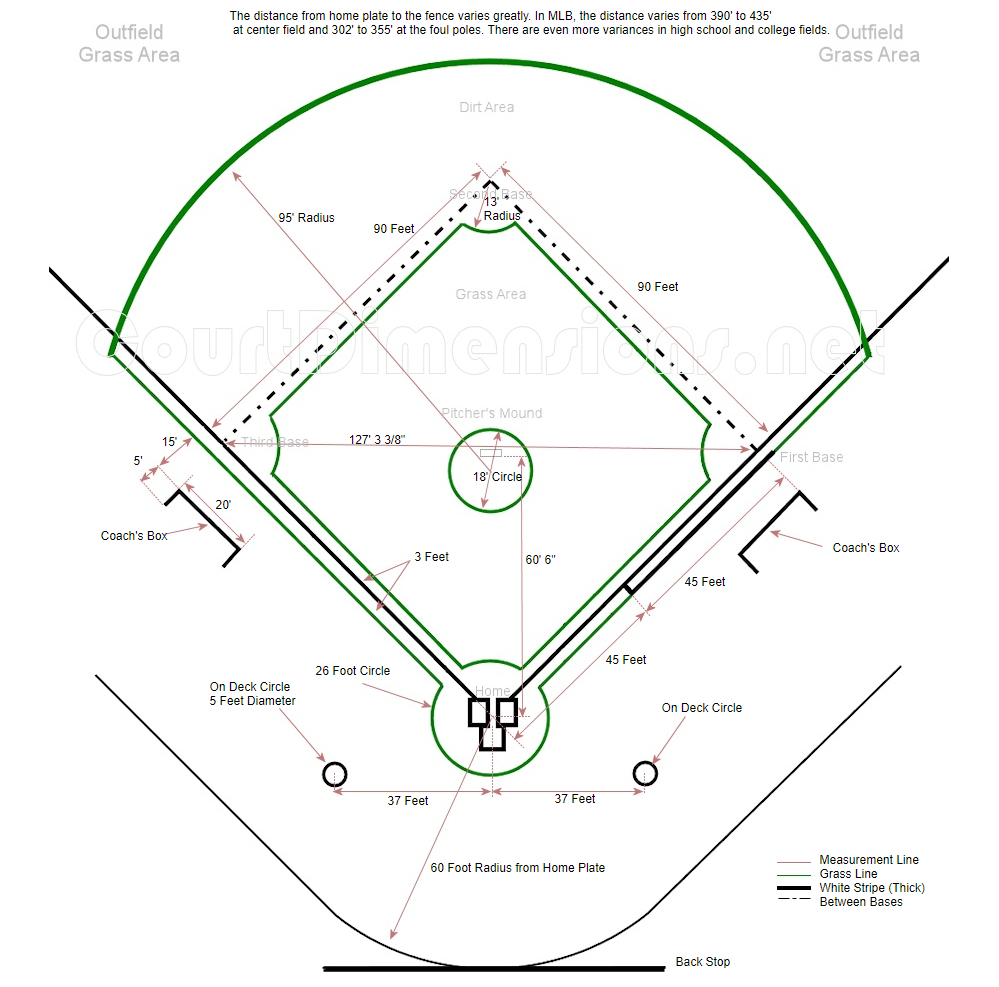Baseball Field Dimensions
Baseball Field Dimensions & Measurements
College & High School Baseball Field Details
At first glance, a baseball field’s layout might be intimidating. But in reality is just a big square turned on a corner with a few arcs. Check out this handy graphic below for a guide on baseball field measurements and layouts.
Quick Facts About Baseball Field Measurements
How tall is a pitcher’s mound?
10 inches above the field. Pitcher’s mounds are unique in that they have a greater slope on the second-base side than the home-plate side.
How far is it to first base?
You gotta run 90 feet.
How far is it from the pitcher’s mound to home?
From the rubber on the mound to home plate it is 60 feet 6 inches.
How far is a home run?
That depends on where you are playing. Baseball fields are not uniform on home run lengths. The vary from 300 feet to 435 feet.
How much area does a baseball field take up?
Again this varies due to the home run fence distance, but you can fit a 120-yard football field inside most baseball stadiums. The distance from the backstop to center field can be as high as 500 feet, or the length of 5 basketball courts.
Baseball: America's Pastime Rooted in Distant History
Few sporting activities are as quintessentially American as baseball. From the crack of the bat to the diamond-shaped field, the game has woven itself into the fabric of U.S. culture and summertime traditions for generations. While professional baseball has endured scandals over gambling, steroids, and labor disputes, its appeal at the amateur, collegiate and major league levels endures.
The origins of baseball trace back surprisingly far before the commonly-cited Abner Doubleday myth. While the U.S. Army officer did promote the game in the 1830s, similar bat-and-ball games had existed across Europe for centuries prior. One of the earliest known references comes from a 1344 poem depicting clergy of St. Gallen’s Cathedral in Switzerland playing a crude version.
More direct links appear in the 1700s, such as the 1744 British children’s book with illustrations depicting “base-ball” played in a triangular configuration using poles as bases. Variations like “town ball,” “round ball,” and “base ball” cropped up in numerous 18th century accounts across North America.
It wasn’t until 1845 that the New York Knickerbocker Baseball Club codified the core rules and field dimensions recognizable today – including the diamond shape, foul lines, and three-strike outs. Alexander Cartwright, a New York bank clerk and founding club member, is now credited as the true “father” who transformed informal “town ball” into the modern baseball we know.
From there, the sport’s popularity rapidly grew, with the first competitive baseball league formed in 1858. Collegiate baseball programs emerged in the 1860s, and professional leagues and governing bodies followed soon after. The legendary Cincinnati Red Stockings of 1869 stand out as the first openly all-salaried nine.
Baseball fever gripped the nation over the next century. Radio broadcasts first brought the action into American homes in the 1920s, cementing the sport’s bond with patriotism, apple pie, and summertime rituals. World War II spawned the racially-integrated All-American Girls Professional Baseball League commemorated in films like A League of Their Own.
Post-war baseball boomed with legends like Jackie Robinson breaking the color barrier, the “Shot Heard ‘Round the World” that brought the Giants fans euphoria, and Don Larsen’s perfect 1956 World Series game. The 1960s-70s saw baseball’s global expansion as Latin American stars ascended while international tournaments sparked new worldwide interest.
Today, Major League Baseball features elite talent from across North and South America, Asia, and the Caribbean. New classic moments like Cal Ripken’s Iron Man streak and the “Curse of the Bambino”-breaking Red Sox championship captivated fans across generations. While football may have eclipsed baseball in total popularity, the summer game remains America’s enduring “national pastime” – a shared heritage whose simple joys of balls, bats, bases and sunshine embody the nation’s spirit.

